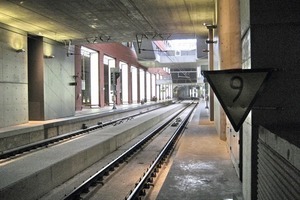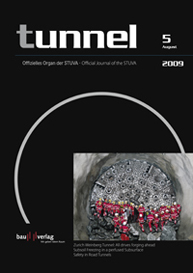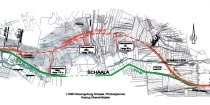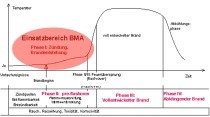Tunnel Smoke Removal System for the Central Station in Antwerp/B
Safety in tunnels is being accorded ever greater importance – and this for good reason. This
applies equally to road and rail tunnels throughout the world. In the following report a smoke removal system for the Central Station in Antwerp in Belgium is presented.
Until recently rail tunnels have scarcely been equipped with tunnel ventilation systems but now these are incorporated in the planning process for many international new construction projects from the onset. This also applies to the tunnel for accessing the newly built underpassage for the Central Station in Antwerp known popularly as the “railway cathedral”. The Belgian railway authority has installed direction-tracing sensors there, which measure the air speed and control the smoke removal systems in the event of fire. These installations are primarily designed to make sure that no smoke penetrates the station should fire break out that would endanger the passengers located there. Vortex volumetric flow sensors – Type VAR TwinPipe produced by Höntzsch – were thus installed.
The disasters in the Mont Blanc Tunnel (March 1999) and 2 months later in the Tauern Tunnel as well as the fire in the Gotthard Tunnel in October 2001 made the risk of fire even more evident in a dramatic fashion. During the 1999 catastrophe in the Mont Blanc Tunnel the smoke was removed and fresh air blown in in such a manner that the smoke in the tunnel tube became turbulent. As a consequence any rescue attempt was no longer possible after a short time as the smoke gases were caught up in turbulence and mixed with the remaining respiratory air in the tunnel very quickly. If the current had remained laminar to a certain degree there would probable have been fewer deaths.
In the case of laminar currents liquids and gases move without turbulences that is to say without eddying. In this case a fluid flows in layers, which do not mix. This safety risk is by no means confined to roads. On July 8th, 2000 a fire broke out in the Berlin “Deutsche Oper” Underground Station during the Love Parade, which saw 350 passengers narrowly escaping a catastrophe.
Smoke Removal requires a “proper” Flow
Clearing smoke from a tunnel represents a difficult fire protection task. The smoke clearance process must be executed in such a way that an adequate amount of time is left for evacuating the tunnel. It has to be said though that rail tunnels have scarcely ever been fitted with mechanical ventilation systems up till now. This is linked to the fact that the impact of toxic substances is considerably lower in rail tunnels, which are mainly operated using electric power, than in road tunnels. In addition, the risk of fire is substantially lower in rail tunnels than in road tunnels, which have to cater for cars and trucks.
However, in the case of projects that are being planned or built at present, an ever increasing number of mechanical smoke removal systems especially for underground stations are foreseen. For instance the Brenner, Gotthard and Lötsch-berg Base Tunnels as well as the Lyon-Turin Base Tunnel, which are currently being built or planned, are to be provided with a mechanical solution. The systems concerned are generally devised as mechanical longitudinal versions and are intended to cater for smoke-free escape routes and a defined longitudinal flow of air in the rail tunnel.
Flow Sensors – Prerequisite for safe Smoke Removal
Tunnel ventilation systems must control the movement of air in the tube comprehensively at an early point in time. Control of the fan/ventilation flaps in order to monitor the air speed correspondingly for the various phases in the event of a disaster and in turn to restrict it, is important for the system’s safety. In this connection a distinction is drawn between the self-rescue and the rescue and fire combating phases, which require different flow conditions for removing the smoke.
The prevailing air/smoke layer should be retained as long as possible while people are being evacuated; as a result a low air speed without reversal of flow is strived for. During the fire combating stage the fire brigade should be able to access the seat of the fire from one side. A “critical flow speed” is required towards this end, i.e. a minimum speed of the air in the tunnel, which must be high enough to ensure that the smoke does not flow in the wrong direction.
In order to fulfil these requirements, it is essential that the flow speed and direction are measured exactly and the smoke flaps and smoke removal units reliable controlled. For this purpose a suitable sensoric system is needed such as for example the Vortex VAR TwinPipe sensor.
Ideal for Use in Tunnels
The VAR TwinPipe sensors do not possess any moveable parts. They are robust and unsusceptible to contamination. Moisture and dust only minimally affect the Höntzsch sensors so that many years of maintenance-free operation is assured. In addition the sensor not only registers air flows given extremely small flow speeds, it also displays the flow direction. In the event of fire this prevents the build-up of air flowing in the wrong direction – something that can be catastrophic.
The measuring range for air/gases lies between ±0.4 to ±25 m/s. The sensors comply with IP68 and are highly suitable for installation in tunnels: the sensor housing and the twin pipe consist of stainless steel, further materials coming into contact with media are ceramic; then there are sealing parts made of silicon. The connection housing with integrated measuring transducer is made of aluminium and furthermore is protected against corrosion. It corresponds to IP67 and requires a 24 VDC supply. The measurement system possesses a 4–20 mA current output and a max. 300 mA relay out-put. The VAR TwinPipes are temperature-resistant from –40° C to +80° C in continuous operation. With a length of only approx. 500 mm for the twin pipe and 240 x 120 x 100 mm (L/B/H) for the connection casing with integrated measuring transducer, the compact measurement system can easily be accommodated in the tunnel tubes.
The size of the TwinPipes particularly appealed to the SNCB, or to be more precise to Infrabel as the company responsible for the Belgian rail infrastructure. After all, the space required for extending the station was restricted. Underground track connections were built at various levels. These included the 1,200 m long twin-track tunnel catering for trains travelling up to 90 km/h, which underpasses Antwerp Central Station thus saving passengers time through obviating the need to uncouple the engines for those en route from Brussels to Amsterdam that has been required up till now. Furthermore the Vortex sensors save Belgian rail the risk of the fire protection safety system breaking down. Trains pass through the tunnel with a relatively low clearance height thus causing considerable impact at the measurement point. The TwinPipe Vortex sensors, which measure via ultrasound, are capable of withstanding these operating conditions.





